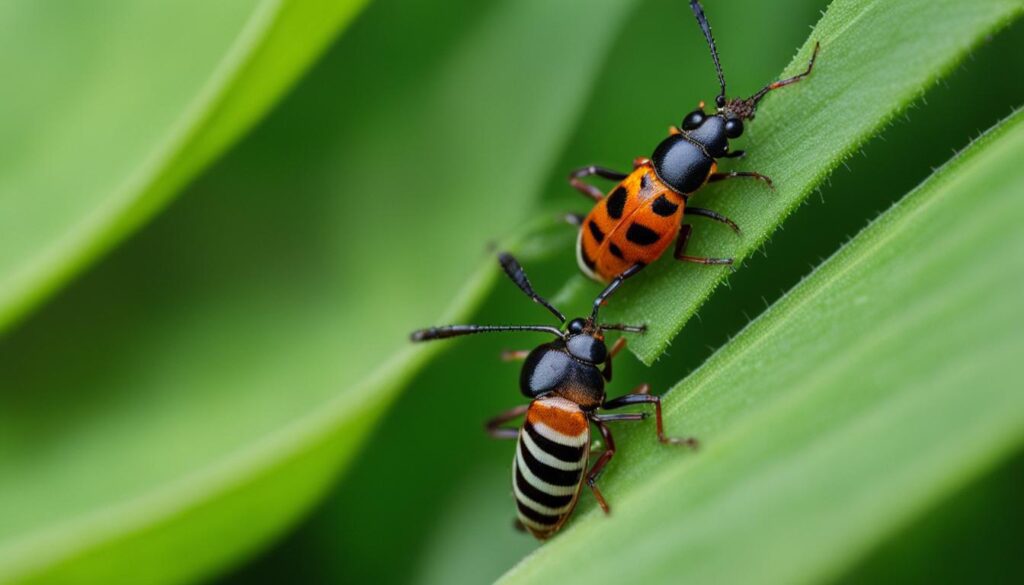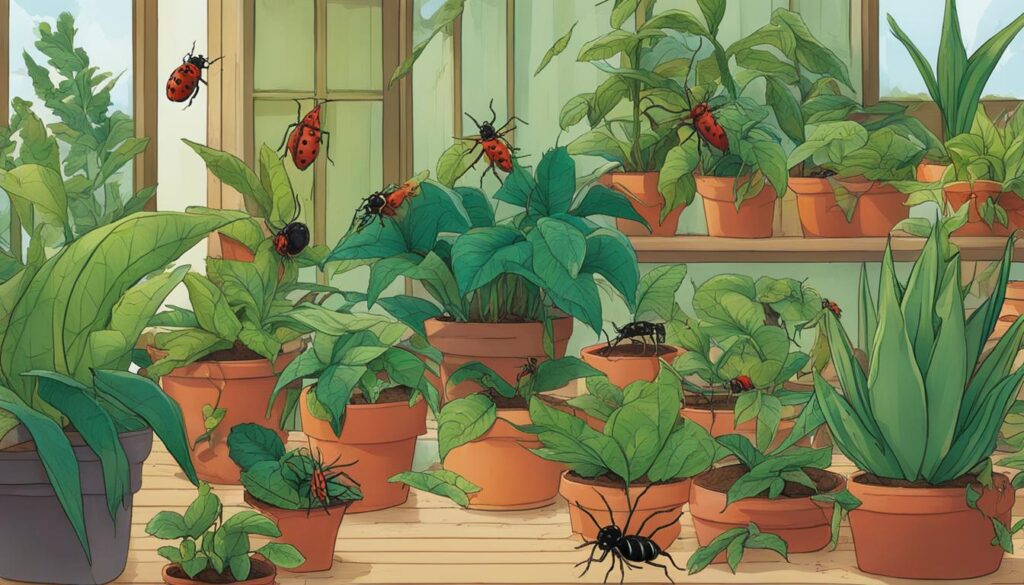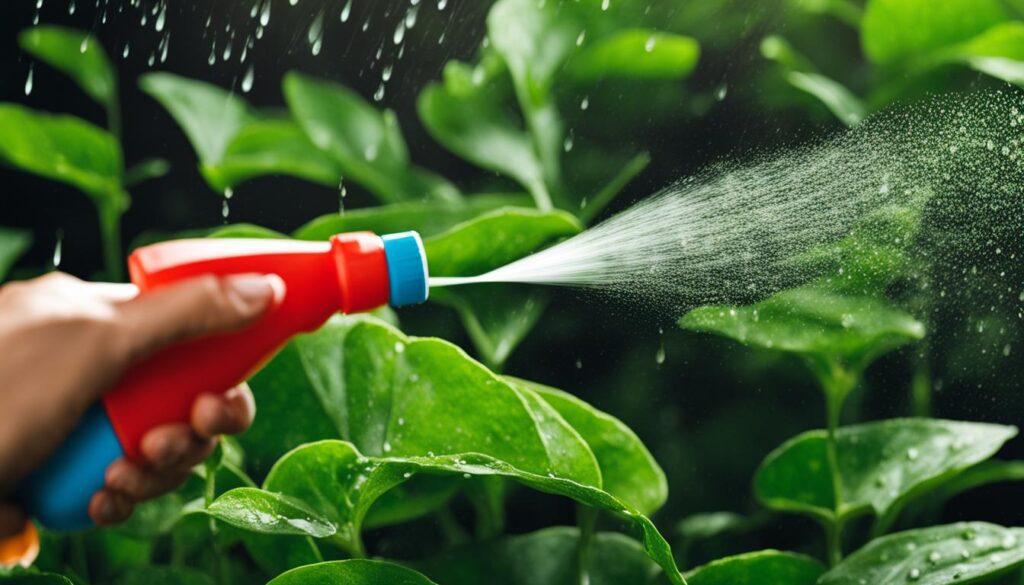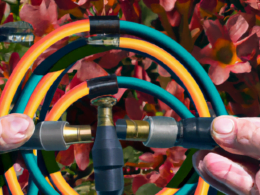Dealing with a pest infestation is every plant owner’s worst nightmare. There’s nothing more frustrating than seeing your beautiful indoor plants plagued by insects. But don’t worry, there are effective methods to keep bugs at bay and ensure your indoor plants thrive.
Indoor plants not only add beauty to your space but also provide numerous health benefits. To maintain their lush greenery and prevent pest problems, implementing pest prevention methods is crucial. Insecticide houseplants can be your secret weapon in the battle against bugs.
Key Takeaways:
- Regularly inspect your indoor plants for signs of pests.
- Choose healthy plants that are suited for your indoor environment.
- Practice proper plant care, including adequate lighting and watering.
- Utilize non-toxic pest prevention methods like homemade sprays or natural treatments.
- If necessary, consider using insecticide houseplants treated with natural insecticides.
Why are there tiny bugs in my houseplants?
Houseplants are not only a beautiful addition to your indoor space but also provide numerous benefits, from purifying the air to boosting mood. However, it can be frustrating to discover tiny bugs crawling around your beloved greenery. Understanding why these pests are attracted to your houseplants is crucial in effectively addressing the issue and ensuring the health of your plants.
Poor Plant Health
One of the main reasons why tiny bugs may infest your houseplants is poor plant health. When plants are stressed, weakened, or lacking proper care, they become more susceptible to pest infestations. Overwatering, for example, can lead to the development of fungus gnats, while dusty leaves may attract spider mites. It’s important to provide your plants with optimal growing conditions, including appropriate watering, adequate light, and regular maintenance, to prevent pest problems.
Attracting Pests
Another factor that can contribute to the presence of bugs in your houseplants is the attraction they create. Insects are naturally drawn to certain characteristics or conditions. For instance, fungus gnats thrive in moist environments, while aphids are attracted to the sap of plants. Dusty leaves, decaying organic matter, and the presence of other infested plants nearby can also make your indoor greens more appealing to pests. By keeping your plants clean, ensuring good air circulation, and addressing any underlying issues, you can help deter these unwanted visitors.
Ensuring Plant Health for Pest Prevention
To minimize the risk of houseplant bug infestations, it’s crucial to prioritize the health of your plants. This includes providing sufficient light, watering appropriately, and maintaining proper cleanliness. Regularly inspect your plants for signs of pests, such as webs, tiny holes, or yellowing leaves. If you notice any infestations, take immediate action to prevent them from spreading. Quarantine new plants before introducing them to your existing collection to avoid introducing pests unintentionally. By implementing these preventive measures and addressing any issues promptly, you can keep your houseplants healthy and free from tiny bugs.
Common Types of Houseplant Bugs
If you’ve noticed tiny pests crawling on your indoor plants, it’s important to identify them accurately so you can take the appropriate steps to eliminate them. Here are some of the most common houseplant bugs you may encounter:
Spider Mites
Spider mites are tiny arachnids that feed on the sap of plants, causing discoloration and webbing on the leaves. They can be identified by the tiny white dots they leave behind on the plant, often forming a circular pattern. Spider mites thrive in warm, dry conditions and can reproduce rapidly, making early detection and treatment essential.
Mealybugs
Mealybugs are small, oval-shaped insects covered in a white, cottony wax. They feed on plant sap and can cause stunted growth, yellowing leaves, and a sticky residue on the plant surface. Mealybugs are often found in clusters, particularly in the leaf axils, undersides of leaves, and along stems.
Aphids
Aphids are small insects that come in various colors and species. They feed on plant sap and can cause distorted growth, yellowing leaves, and the presence of sticky honeydew. Aphids can reproduce quickly, so it’s essential to act promptly to prevent infestations from spreading.
Fungus Gnats
Fungus gnats are tiny black flies that resemble fruit flies. While they don’t directly harm plants, their larvae feed on the organic matter in the soil, potentially causing root damage. Fungus gnats thrive in moist conditions, making overwatering a common factor in their presence.
| Bug | Description | Impact on Plants |
|---|---|---|
| Spider Mites | Tiny, white dots in a circular pattern on leaves | Discoloration, webbing on leaves |
| Mealybugs | Small, oval-shaped insects covered in white, cottony wax | Stunted growth, yellowing leaves, sticky residue on plant surface |
| Aphids | Small insects in various colors and species | Distorted growth, yellowing leaves, presence of sticky honeydew |
| Fungus Gnats | Tiny black flies resembling fruit flies | Potential root damage through larval feeding on organic matter in soil |
By familiarizing yourself with these common houseplant bugs, you’ll be better equipped to identify and address any issues that may arise. Remember to regularly inspect your plants for signs of infestation and take appropriate steps to keep them healthy and bug-free.
What do you spray on plants to get rid of bugs?
When it comes to getting rid of bugs on your indoor plants, there are several natural insecticides that can be effective. Let’s explore some of the most commonly used options:
Insecticidal Soap
Insecticidal soap is a popular choice for controlling soft-bodied insects like spider mites, aphids, whiteflies, and mealybugs. It is made from a mixture of vegetable oil and liquid dish soap. When applied to the affected plants, the soap suffocates the insects, effectively eliminating them. It’s important to use a specifically formulated insecticidal soap for plants, as regular dish soap may harm your plants.
Neem Oil
Neem oil is derived from the seeds of neem trees and is known for its antimicrobial, antibiotic, and pest-killing properties. It is effective against a wide range of pests, including aphids, spider mites, mealybugs, and scale insects. Neem oil works by disrupting the insect’s hormonal system, preventing them from feeding and breeding. To use neem oil, dilute it according to the instructions on the product and spray it onto the affected plants.
Hydrogen Peroxide
Hydrogen peroxide is a versatile solution that can be used to kill fungus gnats and other common bugs. In addition to its pest-killing properties, hydrogen peroxide also provides additional oxygen to plant roots, promoting their overall health. To use hydrogen peroxide as a natural insecticide, dilute it with water (1 part hydrogen peroxide to 3 parts water) and spray it onto the affected plants.
Essential Oils
Certain essential oils, such as tea tree oil, peppermint oil, and rosemary oil, have insect-repellent properties. These oils can be diluted with water or mixed with a carrier oil and sprayed onto the plants to deter pests like aphids. However, it’s important to note that essential oils should be used sparingly and with caution, as some plants may be sensitive to their effects.
Diatomaceous Earth
Diatomaceous earth is a fine, powdery substance made from the fossilized remains of diatoms. It works by dehydrating pests and their larvae, effectively killing them. To use diatomaceous earth as an insecticide, apply a thin layer of the powder onto the soil or directly onto the affected parts of the plant. Be sure to use food-grade diatomaceous earth, as other forms may be harmful to plants.
Remember to always follow the instructions on the product labels when using any insecticides on your plants. It’s also a good idea to test a small area of the plant before applying the insecticide to the entire plant, to ensure that it won’t cause any adverse effects.
| Insecticide | Target Pests | Method of Action |
|---|---|---|
| Insecticidal Soap | Spider mites, aphids, whiteflies, mealybugs | Suffocates insects |
| Neem Oil | Aphids, spider mites, mealybugs, scale insects | Disrupts insect’s hormonal system |
| Hydrogen Peroxide | Fungus gnats, other common bugs | Kills pests and provides oxygen to plant roots |
| Essential Oils | Aphids, other insect pests | Repels pests |
| Diatomaceous Earth | Various pests and their larvae | Dehydrates insects and larvae |
How to Prevent Houseplant Bugs on Indoor Plants
Preventing houseplant bugs is essential for maintaining the health and beauty of your indoor plants. By following a few simple practices, you can create an environment that discourages pests and promotes healthy plant growth. Here are some tips to help you prevent houseplant bugs:
Choose Healthy Plants
Start by selecting healthy plants that are free from pests. Inspect the leaves, stems, and soil for any signs of infestation before bringing a new plant into your home. Choosing healthy plants from reputable sources reduces the risk of introducing potential pests to your indoor garden.
Maintain Cleanliness
A clean environment is inhospitable to bugs. Regularly remove any fallen leaves or plant debris from the soil surface, as these can attract pests. Wipe the leaves with a damp cloth or gently spray them with water to keep them free from dust, which can provide a breeding ground for insects.
Ensure Proper Plant Care
Providing optimal growing conditions for your indoor plants is crucial for preventing bug infestations. Make sure your plants receive adequate sunlight, as weak or stressed plants are more susceptible to pests. Avoid overwatering, as excess moisture can attract fungus gnats. Additionally, follow a regular watering schedule and avoid leaving stagnant water in saucers or trays.
| Prevention Tips | Benefits |
|---|---|
| Inspect plants regularly for signs of pests | Early detection prevents infestations |
| Quarantine new plants before introducing them to your collection | Prevents the spread of potential pests |
| Keep tools, pots, and hands clean | Reduces the chance of introducing pests to your plants |
By following these preventive measures and maintaining a clean and healthy indoor environment, you can significantly reduce the risk of houseplant bugs. Remember to regularly monitor your plants for any signs of infestation, and take immediate action if you spot any pests. With proper care and attention, you can enjoy beautiful, bug-free indoor plants.
How to Manage Insects on Indoor Plants
When it comes to managing insects on your indoor plants, there are several non-chemical methods that you can employ. These methods are effective in controlling pests and minimizing the need for harsh pesticides. By utilizing techniques such as washing, physical removal, and pruning, you can keep your plants healthy and bug-free.
Washing
One of the simplest ways to manage insects on indoor plants is by washing the plant leaves. This can be done by gently wiping the leaves with a damp cloth or spraying them with water. By removing any pests present on the leaves, you can disrupt their lifecycle and prevent further infestation.
Physical Removal
If you spot insects on your plants, physical removal can be an effective method of control. Use tweezers or cotton swabs dipped in alcohol to carefully remove pests like aphids or mealybugs from your plant. For scales, gently scrape them off the plant using a dull knife or your fingernail. By physically removing the insects, you can directly eliminate them from your plants.
Pruning
In some cases, widespread infestations may require more drastic measures. If a plant is heavily infested, pruning can help manage the problem. By removing the infested parts of the plant, you can reduce the population of insects and prevent the infestation from spreading. Remember to dispose of the pruned plant material properly to prevent reinfestation.
By utilizing these non-chemical methods of pest management, you can effectively control insects on your indoor plants. These techniques not only help keep your plants healthy but also minimize the use of harmful chemicals in your home. Remember to regularly inspect your plants for pests and take prompt action if an infestation is detected.
| Non-Chemical Pest Management Techniques | Benefits |
|---|---|
| Washing | Removes pests from plant leaves |
| Physical Removal | Directly eliminates insects from plants |
| Pruning | Reduces population of insects and prevents spread of infestation |
Can Natural Solutions for Houseplant Bugs Be as Effective as Insecticide Houseplants?
When dealing with pesky houseplant bugs, many people are opting for a natural houseplant bug remedy instead of relying on insecticide houseplants. These natural solutions can be just as effective in controlling infestations without harming the environment or risking the health of our beloved plants. By using organic methods like neem oil, beneficial insects, or homemade insecticidal sprays, we can keep our houseplants healthy and bug-free while embracing a more sustainable approach.
Conclusion
Keeping your indoor greens bug-free is essential for maintaining a healthy and thriving indoor garden. By implementing effective pest prevention methods and practicing regular plant care, you can enjoy bug-free indoor greens all year round.
Choosing insecticide houseplants, treated with natural insecticides, can be a great way to prevent and eliminate bugs. These specialized plants are designed to repel pests and provide an extra layer of protection for your indoor foliage.
However, it’s important to remember that insecticide houseplants are not a standalone solution. They should be used in conjunction with other pest prevention methods, such as proper plant care and cleanliness. Regularly inspecting your plants for pests, providing sufficient light and water, and keeping your tools clean can help minimize infestations.
By following these practices and being proactive in managing pests, you can create a bug-free environment for your indoor greens. So, invest in insecticide houseplants, implement the right pest prevention methods, and enjoy a thriving and pest-free indoor garden.
FAQ
Why are there tiny bugs in my houseplants?
Houseplant bugs are attracted to plants that are in poor health or are in subpar environments. Over-watering can attract fungus gnats, while dusty leaves can attract spider mites. Stressed plants are more likely to attract pests. However, healthy, well-cared-for plants are less attractive to pests.
What are the common types of houseplant bugs?
The most common bugs that plague houseplants include spider mites, mealybugs, aphids, and fungus gnats. Spider mites can be identified by webbing on the plant and tiny white dots in a circle. Mealybugs are small, oval white bugs that secrete sugary wax. Aphids come in different colors, shapes, and species and feed on plant sap. Fungus gnats are tiny black bugs that thrive in moist conditions and can be mistaken for fruit flies.
What do you spray on plants to get rid of bugs?
There are various natural insecticides that can effectively get rid of bugs on plants. Insecticidal soap, made from vegetable oil and liquid dish soap, is effective against soft-bodied insects like spider mites, aphids, whiteflies, and mealybugs. Neem oil, extracted from neem trees, is a natural pesticide with antimicrobial, antibiotic, and pest-killing properties. Hydrogen peroxide can kill fungus gnats and other common bugs, as well as provide additional oxygen to plant roots. Essential oils like tea tree oil can repel pests like aphids. Diatomaceous earth, a food-grade powder, can dehydrate bugs and their larvae.
How to prevent houseplant bugs on indoor plants?
To prevent houseplant bugs, it’s important to choose healthy plants with growing requirements that match your indoor environment. Proper plant care, including sufficient light, proper watering, and regular cleaning, can minimize pest issues. Regularly inspecting plants for pests, quarantining new plants, and keeping tools, pots, and hands clean can also help prevent infestations.
How to manage insects on indoor plants?
Many insect problems on indoor plants can be managed using non-chemical methods. Washing plant leaves with a damp cloth or spraying them with water can remove pests. Physical removal using tweezers, cotton swabs dipped in alcohol, or scraping scales can also be effective. Pruning infested parts of the plant can help manage widespread infestations. Pesticides containing ingredients like pyrethrins, insecticidal soap, neem oil, and plant oil extracts can be used as a last resort if non-chemical methods fail.
Can insecticide houseplants help keep my indoor greens bug-free?
Yes, insecticide houseplants, such as those treated with natural insecticides, can be effective in preventing and eliminating bugs. By choosing healthy plants, providing optimal growing conditions, and implementing non-chemical pest management techniques, you can maintain healthy, pest-free indoor plants.












